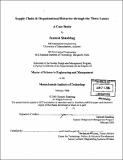Supply chain & organizational behavior through the three lenses : a case study
Author(s)
Shanbhag, Santosh, 1976-
DownloadFull printable version (11.05Mb)
Alternative title
Supply chain and organizational behavior through the three lenses
Other Contributors
System Design and Management Program.
Advisor
Daniel Whitney.
Terms of use
Metadata
Show full item recordAbstract
Introducing change in any company, organization or institution has never been an easy task to accomplish. There is always a resistance to change, as change creates confusion in the minds of people, makes them uncomfortable and requires compromises and adjustments in the way people are used to functioning. However, for the advancement of technology, organizations, society and life change is inevitable and will take place sooner or later. This thesis focuses on one such change - change in operational behavior in addressing a new market entry (IC programming socket market) by the semiconductor bum-in socket business unit of ACME Inc. The new market entry is done such that the solutions currently provided in the bum-in market are made to operate in a larger solution space with minimal changes to the product/solution to help maximize profitability of the same. This thesis discusses the differences between the two semiconductor test markets and the similarities between the solutions offered. Further, applying Paul Carlile's approach of using the Three Lenses approach in analyzing an organization - Strategic, Cultural and Political, the thesis brings out the salient issues in employing the new market entry strategy through an organizational perspective. (cont.) In addition, the thesis discusses some fundamental inventory management techniques and application of the same to the development of an inventory management program. The deployment of 'all customers are not equal, all products are not equal and all service levels are customer-product level dependant' strategy helps in addressing the issues identified by the Three Lenses. Besides the identification of the strategy, the thesis also shows the importance of the implementation phase to the success of the program. Sharing the inventory analysis with the implementation team; identifying the market opportunity and sharing its effect on the top and bottom line with the management team; political influences required to get the team (direct and indirect) on board are the steps that were taken, without which implementation of the new market entry strategy would have seen a different end. On brining the two overarching business principles of organizational behavior and supply chain management together, ACME Inc. now enjoys the benefits of entering a new market with minimal engineering resources. It provides the organization an increase in profitability through product reuse, avoiding high volume manufacturing disruptions, avoiding not on time delivery excursions and a successful entry into a new market.
Description
Thesis (S.M.)--Massachusetts Institute of Technology, System Design and Management Program, February 2006. Includes bibliographical references (p. 82-83).
Date issued
2006Department
System Design and Management Program.Publisher
Massachusetts Institute of Technology
Keywords
System Design and Management Program.